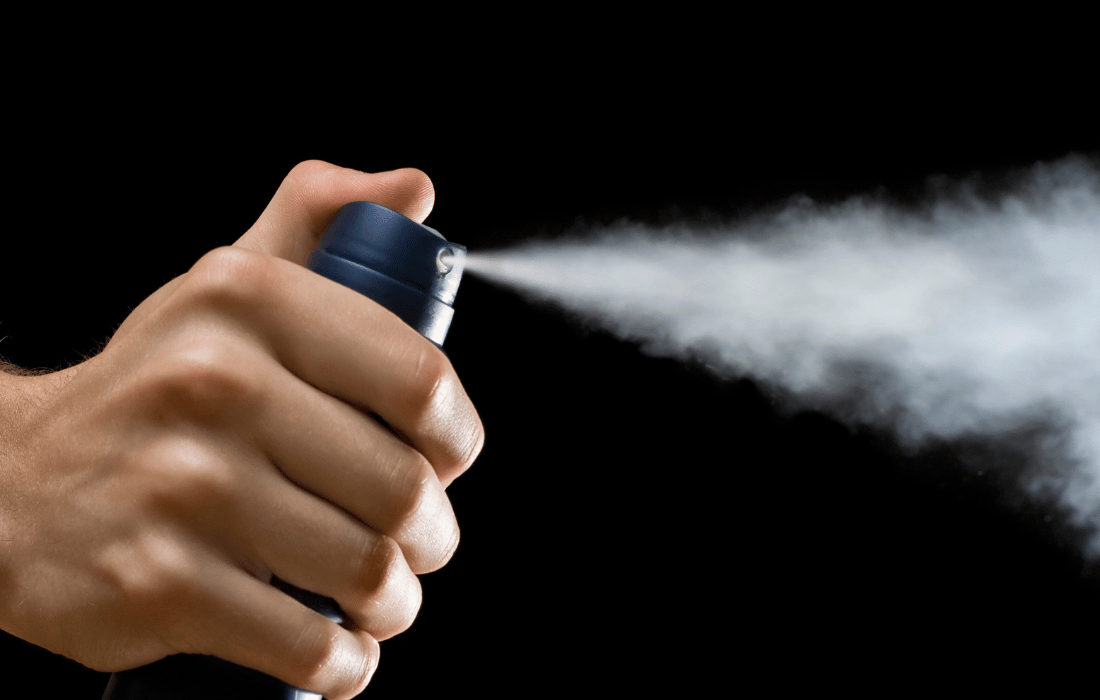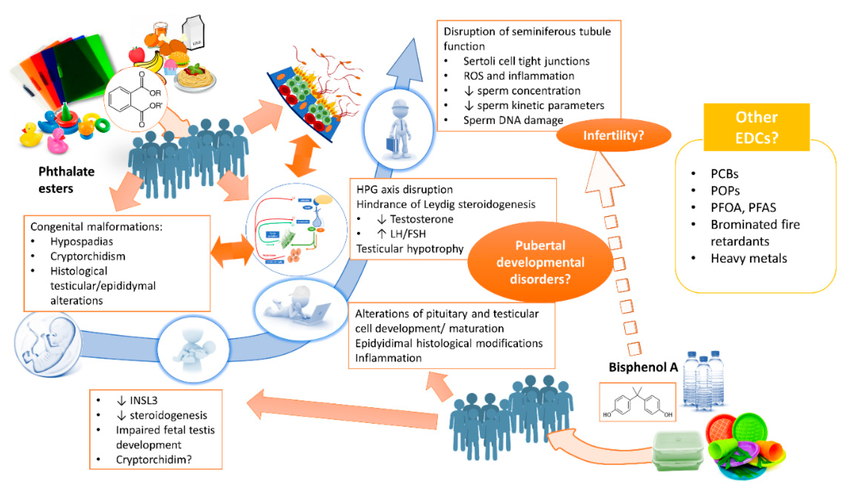Walk into any store, and you’re bombarded with the alluring scents of citrus, musk, or fresh linen wafting from body sprays, deodorants, colognes, and air fresheners. While these fragrances might seem harmless—just a splash of luxury in everyday life—the truth is far murkier. Behind the veil of enticing aromas lies a cocktail of synthetic chemicals, many of which are now recognized as endocrine disruptors capable of wreaking havoc on your body’s hormone system.
What Are Endocrine Disruptors, and Why Should You Care?
Endocrine-disrupting chemicals (EDCs) are substances that interfere with your body’s hormone system, mimicking or blocking natural hormones like testosterone and estrogen. Your endocrine system regulates everything from metabolism and mood to reproduction and immune function, and when these systems are thrown off balance, the consequences can be severe.
Many EDCs work by binding to hormone receptors in the body, essentially hijacking natural processes. Others inhibit the body’s ability to produce or break down hormones, leading to an excess or deficiency of key regulatory compounds. This disruption can cause issues such as:
Reduced testosterone production, leading to decreased muscle mass, lower libido, and infertility in men.
Increased estrogenic activity, which can contribute to conditions like gynecomastia (male breast growth) and even hormone-related cancers.
Thyroid dysfunction, affecting metabolism, energy levels, and cognitive function.
Neurological impairments, particularly in developing children, due to disrupted hormone signaling in the brain.
These issues are not just theoretical—scientific studies have repeatedly demonstrated the links between synthetic fragrance chemicals and endocrine disruption. The synthetic fragrance industry, worth billions, has been quietly infusing our daily routines with these harmful compounds, with little regulation and even less transparency. The question isn’t whether these chemicals are affecting us—it’s how much damage they’re already doing.
The Fragrance Industry’s Dirty Secrets
Most consumers have no idea that their favorite colognes, body sprays, or even “clean” laundry detergent could be messing with their hormones. The fragrance industry operates under lax regulations, allowing manufacturers to hide dozens of harmful chemicals under vague labels. Here’s why you should be concerned:
The Mystery Ingredient List
Here’s the kicker—fragrance formulas are considered trade secrets. That means companies can legally hide hundreds of chemicals under the innocent-sounding label of “fragrance” or “parfum.” According to the Environmental Working Group (EWG), the average fragrance product contains at least 14 undisclosed chemicals, many of which have been linked to hormone disruption, allergies, and respiratory issues.
Several commonly used fragrance ingredients have been identified as endocrine disruptors. Here’s a closer look at some of the worst offenders:
Phthalates: The Testosterone Thieves
Phthalates are plasticizers used to help fragrances cling to skin and linger in the air. They are also notorious for lowering testosterone levels. Studies have found that men with higher phthalate exposure have lower sperm counts, decreased libido, and even increased rates of erectile dysfunction.
A study published in Human Reproduction found that men with high urinary levels of phthalates had significantly reduced testosterone and insulin-like factor 3 (INSL3), a key marker of Leydig cell function in the testes.
Exposure to phthalates in utero has been linked to decreased anogenital distance in male infants—a marker of feminization due to disrupted androgen production.
Parabens: The Estrogen Mimics
Parabens are used as preservatives in fragrances and personal care products. They mimic estrogen in the body, which can disrupt male reproductive health and increase the risk of hormone-related cancers.
A Reproductive Toxicology review highlighted that parabens can be absorbed through the skin and accumulate in fat tissue, interfering with natural hormone signaling.
Studies have found parabens in breast cancer tumors, suggesting their role in hormonal imbalances and carcinogenesis.
Synthetic Musks: The Persistent Pollutants
Compounds like nitro musks and polycyclic musks are synthetic versions of natural musk, added to give fragrances a long-lasting scent. However, they don’t just stick to your skin—they accumulate in your fat cells and even breast milk.
Studies show that these musks act as endocrine disruptors, altering hormone receptor activity and affecting reproductive function.
They have been detected in human blood samples, proving that they are not easily broken down or eliminated from the body.
The Domino Effect: How These Chemicals Sabotage Your Health
Fragrance chemicals don’t just interfere with your hormones—they create a ripple effect throughout your body, leading to a cascade of health problems. From fertility issues to metabolic disorders, the consequences of daily exposure are more serious than most people realize.
Metabolic Chaos: The Link to Obesity and Diabetes
Endocrine disruptors in fragrances don’t just mess with your reproductive health—they also tamper with your metabolism.
Some fragrance chemicals act as obesogens, chemicals that promote fat storage and disrupt insulin sensitivity.
Research shows that phthalates may contribute to insulin resistance and increased risk of Type 2 diabetes.
Cognitive and Neurological Effects
Your brain is not immune to the effects of synthetic fragrances. Many of these chemicals can cross the blood-brain barrier and have been linked to neurodevelopmental disorders and cognitive impairment.
Several studies have found that prenatal exposure to certain phthalates was associated with lower IQ scores in children.
Chronic exposure to synthetic musks has been implicated in neurotoxicity, with potential effects on memory and focus.
Respiratory Issues and Allergic Reactions
Fragrances don’t just disrupt hormones—they can also wreak havoc on your respiratory system. Many synthetic scent compounds emit volatile organic compounds (VOCs), which degrade indoor air quality and trigger allergies or asthma.
A study in Air Quality, Atmosphere & Health in 2015 found that 37 common consumer products emitted 156 different VOCs, with 42 classified as toxic or hazardous under U.S. federal laws.
Another 2019 study found that 57.8% of asthmatics reported adverse health effects from exposure to fragranced products, with 24.1% experiencing potentially disabling reactions.
Testosterone Decline and Male Fertility Crisis
The modern male is facing a fertility crisis, with sperm counts plummeting by over 50% in the past four decades. While multiple factors are at play, exposure to synthetic fragrance chemicals is an overlooked culprit.
Science shows that phthalate exposure reduces sperm motility and concentration in men.
Chronic exposure to EDCs has been associated with increased estrogenic activity in men, leading to symptoms like gynecomastia (male breast growth), decreased muscle mass, and even mood disorders.
How to Protect Yourself from Fragrance-Induced Endocrine Disruption
The good news? You don’t have to be a passive victim of the fragrance industry’s reckless disregard for health. By making informed choices, you can significantly reduce your exposure and protect your hormone balance.
1. Read Labels and Avoid “Fragrance” or “Parfum”
If you see “fragrance” or “parfum” listed in the ingredients of a product, chances are you’re exposing yourself to a mix of undisclosed endocrine disruptors. Opt for fragrance-free or naturally scented products instead.
2. Choose Natural, Organic Alternatives
While many turn to essential oils as a natural alternative, not all are harmless. Oils like lavender and tea tree have been linked to endocrine disruption due to their estrogenic and anti-androgenic properties. Floral essential oils can still impact hormone balance, particularly with prolonged exposure. For those prioritizing detoxification, avoiding strong scents altogether may be the best route—if your body is clean on the inside, there’s no need to mask odors on the outside.
3. Ditch Scented Household Products
Synthetic fragrances aren’t just in personal care items—they’re in candles, air fresheners, laundry detergents, and cleaning products. Opt for unscented or naturally derived options, such as organic beeswax candles, to minimize exposure.
4. Detox Your Home with Indoor Plants and Air Purifiers
Instead of masking odors with synthetic scents, use activated charcoal, baking soda, and air-purifying plants like peace lilies or snake plants to naturally cleanse indoor air. Invest in a high-quality HEPA air purifier for cleaner air and total peace of mind.
5. Support Transparency in the Fragrance Industry
Demand better regulations by supporting brands that disclose all ingredients. The push for “clean beauty” and “non-toxic” labeling is growing—be part of the movement for healthier personal care products.
Final Thoughts: Smelling Good Shouldn’t Cost You Your Health
The fragrance industry has managed to keep its dirty little secret hidden for too long, but the science is clear—many of these chemicals are wreaking havoc on men’s health. The good news? You have the power to take control of your exposure. Making simple swaps in your personal care routine can go a long way in protecting your hormones, fertility, and overall well-being. It’s time to break free from the toxic spell of synthetic fragrances and reclaim your health, one scent-free choice at a time.








